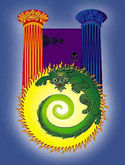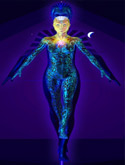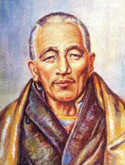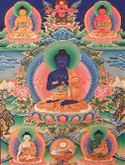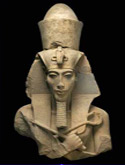Sagittarius 2003: Odysseus. Strider. Gandalf.
 Keynote
Keynote
“I see the goal. I reach the goal and see another.”
Odysseus, Strider and Gandalf: Sagittarian Archetypes
A note here for some new students about any sign that we consider. You do not have to be ‘a Sagittarius’ Sun sign to respond to these forces. Many of you will have important planets in Sagittarius, such as the Moon or Jupiter, or may even have it as your rising sign. Some may have been born in Libra or Scorpio but will find that the progressed Sun occupies Sagittarius for thirty years, creating a powerful ‘subtone’ note throughout the life.
Likewise, whenever planets transit through Sagittarius on a regular basis, they will be aspecting parts of your horoscope and hence bringing those forces through. An example is Pluto moving through Sagittarius on a long term basis, creating major aspects for anyone that has planets in mutable signs. In fact Pluto conjoins the Sun at this full moon, in a powerful T-square focusing on Jupiter in Virgo. As I mentioned last newsletter or so, it is a strong expression of the second ray of Love-Wisdom.
Be reminded of the opportunities and challenges that take place as a result of the passage of the Sun through the zodiac signs, impressed upon us most strongly during the five-day full moon period. As a result of cultivating that inner awareness we can only become more empowered on a daily basis, and are able to generate more compassion through wider understanding.
Sagittarius was the subjective influence on Humanity 21 million years ago when the Hierarchy were approaching to stimulate and fan the ‘spark of mind’, hence it rules human evolution.
Sagittarius is the sign of the one-pointed questing disciple, the archer aiming unerringly toward the target. As a fiery sign, with the flames of aspiration fuelling the vision, Sagittarius drives upward and onward, daring to venture ‘where angels fear to tread’. Hence the adventurous spirit of Sagittarius, like Odysseus the world wanderer or Strider from The Hobbit, and thus the reason why Sagittarius rules the thighs, that source of locomotion for following the Path. That path can lead through many lands, replete with various cultures and rich traditions, or it can be the inner landscapes that the seeker dares to traverse in meditation deep.
This sign rules higher academic education, that stage of the path where the intelligentsia excel. In later incarnations after having developed the intellect, it falls below the threshold of consciousness and simply becomes a vehicle for that sixth and higher synthetic sense, the intuition. Esoterically Sagittarius is regarded as a sign of intuition, where the invocative fires of aspiration evoke the returning ‘arrow of intuition’.
Krishnamurti had the Moon in Sagittarius, representing many lifetimes of developed intellect, stored wisdom and intuition. In his younger years at school he was regarded as ‘dim-witted’ and hated book-learning, not unlike fellow Sagittarian Akbar the Great, an incarnation it is said, of the Master Morya. When being groomed by the theosophical society, K failed his examinations into university, yet later in life could hold his own with the greatest thinkers and scientists of the twentieth century; this with hardly or no prior reading or training in those respective disciplines.[1]
Gemini is the polar-opposite sign to Sagittarius, bearing in mind that the twelve zodiac signs are regarded as six pairs of signs wherein the conflicting opposites are harmonised and balanced. The Gemini- Sagittarius axis is one of the major conditioning forces of Humanity as a whole, relating respectively to the intellect-intuition just discussed.
The Gemini polarity for the global ‘Strider’ is the innate human curiosity and spirit of enquiry which leads to the many experiences of the soul incarnate. It can also be the many highways and bi-ways that can detour the seeker from the truth which is sought. One can become bound by false teachers like Hercules chained to the rock by Busiris. Another mutable sign, Pisces, which rules the feet, is known to wander the ‘circuitous route’ back to the ‘Father’s House’. We can see how the mutable cross as a whole rules Humanity, being generically where most non-soul infused experience occurs. Gemini-Sagittarius is restless Humanity, drifting through time, wandering through space searching for its soul.
The Gemini polarity is also where Sagittarius can get distracted in too many ideas that create many options, the starting of many projects, but never finishing any. The one-pointed focus of Sagittarius must be maintained otherwise dissipation ensues; also a big lesson for Gemini’s of course. This is not to say that Gemini is not intuitive, far from it – there are lower and higher expressions of all the signs.
Gemini can get stuck in the collection and assimilation of knowledge without any application to life, or a too strict a reliance upon concrete data. This leads to a mistrust of the intuition, and the Western world suffers from this en masse. To break out of this paradigm takes Sagittarian daring and confidence to access the intuition.
The taught bow of the developed intellect, drawn to a point of high tension, with a steady arm and a focused eye, releases the arrow of intuition toward its target: an awesome combination of buddhi-manas. That is why the modern symbol for Sagittarius is now simply the bow and arrow. This developed intuition and focus is said by DK to ‘suffice to carry the man to the foot of the mountain of initiation in Capricorn’.
The idealism and aspiration of Sagittarius is at once its great talent and its Achilles Heel. There is a lot of passion and emotionality with Sagittarians, ruled by Mars at its highest or ‘hierarchical’ level. Mars also rules the solar plexus centre through which the emotional body expresses. As hierarchical ruler of Sagittarius, Mars relates to the ‘lunar’ lower self, or the bodies of the personality: physical, astral and mental – built by the lunar devas.
Hence Sagittarius can be very earthy and sensuous, totally ruled by the passions and the perennial ‘party animal’, promiscuous as its ruler, Jupiter – in his Greek guise as Zeus, king of the gods:
“We are told that Sagittarius governs the thighs, which are the main centre of physical power and protective strength, and also the sacral centre which provides the energy for the use of the creative powers of the physical life. This is also symbolically true.
In Sagittarius, the disciple has two things to discover within himself; these are the power to make progress upon the path and to walk the Way, and also the ability to create in the higher and spiritual sense. This concerns the relationship between the sacral and the throat centres. These powers (the higher powers) are as yet embryonic in the earlier Sagittarian experience of the disciple, but they become more developed and potent as he cyclically returns to life experience in this sign.”[2]
The reorientation to the throat centre leads eventually to illumination and ‘transfiguration’. The Master D.K. has said that one of the ways to re-orient oneself from the desire of the solar plexus centre is to replace it with aspiration to the Christ-life of the Heart. Hence the intense zealousness of the Sagittarian aspirant and the yearning for the transcendental, visionary experience – seen particularly in the Islamic and Christian mystics. Both these religions are ruled by the sixth ray and this ray expresses itself most potently in this cycle – through Sagittarius – as I have mentioned in several other newsletters.
The downside of this polarisation is fanaticism, fundamentalism, obsessive behaviour and tunnel vision. There is a strong emotional adherence to ideas that have not been fully thought out and a righteousness that proclaims right-ness and ‘this way is the only way’. Hence we see Pluto’s transit through Sagittarius currently sweeping all religious dogma before it, like old dead leaves before the broom of the coming Bodhisattva. Yet the ‘upside’ is the one-pointedness that breaks through to the other side.
Sagittarian expansiveness via its ruler Jupiter can express as mild exaggeration in order to make a point, or wild exaggeration which is pure story-telling! The truth is compromised or lost sight of completely – ironically in the sign of the Seeker after Truth. This is a fascinating facet of the various shades of illusion, and one that is mirrored in the polar-opposite sign Gemini, known for its devious sleight-of-mind. Nevertheless, Sagittarius is a good spinner of yarns and has many tales from its adventures in far-flung lands!
The fourth ray of Harmony and Beauty is one of the rays that come through Sagittarius, complimenting its storytelling ability. The third ray of active intelligence also passes through this sign, reminding us of the aforementioned third throat centre and the third initiation – not to mention its talent for ’embroidery’.
Sagittarius is the knight charging on his white horse with lance at the ready. The days of chivalry relate to the ethical and moral side of Sagittarius, which can also be extremely judgemental and hypocritical, especially with Saturn or the Moon placed here. Spain which is ruled by Sagittarius at the soul level, was the initiator of the (Christian) Spanish Inquisition responsible for persecuting and murdering millions of ‘heretics’ – in the name of Christ! Soul energy can distort through any entity that has not attended to its personality shortcomings, in Spain’s case, Capricorn, representing crystallised ideas.
Yet from the soul of the Spanish nation emerged the story of Don Quixote (a classic Sagittarian archetype), ‘conceived as a comic satire against the chivalric romances’….’He is an elderly knight who, his head bemused by reading romances, sets out on his old horse Rosinante, with his pragmatic squire Sancho Panza, to seek adventure. It is, among other things, a parable of the “republic of enchanted men,” living in a world of illusions and tilting at windmills.’[3]
The word ‘illusion’ is the polar opposite to ‘intuition’. Illusion we are told relates to the mental plane, whilst glamour to the astral and maya to the physical. This illusion-intuition coupling is most descriptive of Sagittarius’ problem. The illusory world of ideas, coloured by idealistic notions that taint human thinking. The movement from the mental to the astral to the physical can be seen as the idea, the ideal and the idol.
Sagittarius is good at seeing the wide blue horizon or the greater cosmic picture but is not necessarily discriminating at filtering its impressions. (It needs to draw upon the Virgo arm of the mutable cross to separate the wheat from the chaff.) This impressionability is the quality of the Gemini polar-opposite and contributes to the wonderful naivety of Sagittarius. Yet beguiling Busiris can also side-track the gullible Sagittarian into the follower of a cult, or indeed, be the intiator of one. ‘Cult’ is here defined as the dominating ‘idee fixe’ or illusion of a cult’s leading personality – their names are legion.
“a. The Contrast between Illusion and Intuition.
Illusion is the power of some mental thoughtform, of some ideal, and some concept – sensed, grasped and interpreted in mental form – to dominate the mental processes of the individual or of the race and consequently to produce the limitation of the individual or group expression. Such ideas and concepts can be of three kinds, as I realise you should know:
1. They can be inherited ideas, as in the case of those who find it so difficult to adjust themselves to the new vision of world life and of social order, as expressed in the newer ideologies. They are powerfully conditioned by their cast, their tradition and their background.
2. They can be the more modern ideas which are, in the last analysis, the reaction of modern thought to world conditions and situations, and to these many other aspirants are very prone and most naturally so, especially if living in the vortex of force which we call modern Europe. Such modern ideas are construed today into major currents and dominating ideologies, and to these every intelligent person must inevitably react, though they forget that that reaction is based on tradition, or upon national or international predisposition.
3. They can be the newer dimly sensed ideas which have in them the power to condition the future and lead the modern generation out of darkness into light. None of you as yet really sense these new ideas, though in moments of high meditation and spiritual achievement, you may vaguely and briefly react to them. That reaction may be real just in so far that it conditions, with definiteness, your service to your fellowmen. You can react correctly and can do so increasingly if you preserve your soul’s integrity and are not overcome by the battle and the fever of your surroundings within your chosen field of service.
A mental illusion might perhaps be described as an idea, embodied in an ideal form, which permits no room or scope for any other form of ideal. It precludes an ability, therefore, to contact ideas. The man is tied to the world of ideals and of idealism. He cannot move away from it. This mental illusion ties and limits and imprisons the man. A good idea may consequently become an illusion with great facility and prove a disastrous conditioning factor in the life of the man who registers it.
An illusion can, therefore, be defined as the consequence of an idea (translated into ideal) being regarded as the entire presentation, as the complete story or solution and as being separated from and visioned independently of all other ideas – both religious in nature or apparently completely unrelated to religion. In this statement lies the story of separation and of man’s inability to relate the various implications of a divine idea with each other.
When visioned and grasped in a narrow and separative manner, there is necessarily a distortion of the truth, and the disciple or aspirant inevitably pledges himself to a partial aspect of reality or of the Plan and not to the truth as far as it can be revealed or to the Plan as the Members of the Hierarchy know it.
This illusion evokes in the disciple or idealist an emotional reaction which immediately feeds desire and consequently shifts off the mental plane on to the astral; a desire is thus evoked for a partial and inadequate ideal and thus the idea cannot arrive at full expression, because its exponent sees only this partial ideal as the whole truth and cannot, therefore, grasp its social and planetary and its cosmic implications.”[4]
Eventually the errant knight becomes the Rider on the White Horse, the Christed One or Kalki Avatar, who has triumphed over illusion. The sword of reason (buddhi-intution) has cleaved the veil of illusion, the last barrier to slaying the Dweller on the Threshold. The rider (or Strider) controls the animal nature and astride his steed gallops headlong to triumph in Capricorn. Strider’s co-striver, Gandalf the Grey, has become Gandalf the White, charging down the steep to Helm’s Deep, the hell realm, to battle the Orc-hordes of maya.
Sagittarius as the previous sign to Capricorn, ‘seeds’ that ‘raincloud of knowable things’ as Patanjali puts it, and manifests it upon the physical plane in earthy seventh-ray Capricorn. The higher spiritual principles are contacted in intuitive Sagittarius and codified into earthly laws in Capricorn; the ‘Return of the King’ that rules in Capricorn is the triumphant raja-yogi.
Perhaps this relates partly to why Sagittarius rules the Master Mason’s (M.M.) degree[5], also known as the Third Degree initiation. The candidate has conquered illusion and been illumined, transfigured in and by the light. The ‘lunar lords’ of the personality no longer control and hence are occulty ‘dead’ – but ‘raised’ to new life. Now a few drops presage the approaching monsoon at the end of the Age of Aquarius, when substantial numbers of Humanity will have reached this stage of unfoldment; now is the stage of the ‘forerunner’.
Phillip Lindsay © 2003.
Other Sagittarius newsletters.
Subscribe to newsletter.
Donations
Please support this work.
Stripe is supported in many countries.
[1] See The Initiations of Krishnamurti, Phillip Lindsay.
[2] Esoteric Astrology, Alice A. Bailey. p.191.
[3] Encyclopedia Britannica CD.
[4] Glamour: A World Problem. Alice A. Bailey. pp.129-130.
[5] Esoteric Astrology, Alice A. Bailey. p.64.



